The flintlock has an ignition system and mechanism similar to the earlier used wheel-lock. It produced its spark by striking a flint (stone) against steel. Since these firearms weighed less and were simpler and cheaper to make, they soon became more popular.
It had a hammer-like part called a cock. Clamped in this cock was the flint. Opposite the flint was the frizzen or steel. The firearm was prepared for firing by moving the frizzen forward and pouring the priming powder into the flash pan, whilst ensuring that the falsh hole in the side of the barrel was unobstructed. Once done, the frizzen was then pulled back and held by the frizzen spring to close over and cover the priming powder in the flash pan. The hammer-like part was then manually pulled back "cocking" the action to full cock. When the trigger was pressed, the cock was released and the mainspring housed inside the lock snapped it forward and down to strike the frizzen with the flint. This in turn produced sparks which fell into the priming powder in the flash pan igniting it. This priming powder then burnt sending a flame through the flash hole in the side of the barrel to ignite the main charge.
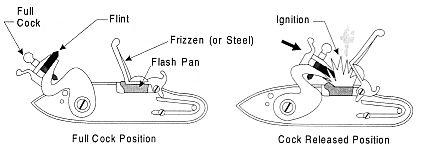
(with acknowledgement to the Department of Justice Canada)
"The lock shown below by Rigby of Dublin in a good example of the flintlocks development by 1800. By no means do all locks of this period reflect the quality and workmanship shown here.
Lets have a look.
The lock shown has two external features often found on locks of the 1800 period, a rain-proof pan and a roller on the frizzen spring. When the frizzen is in the down rearward most position, its bottom shape neatly covers the flash pan leaving a recess front and rear of the pan. The roller on the frizzen spring acts to minimize friction with the foot of the frizzen and most importantly to precisely regulate the action of the frizzen.
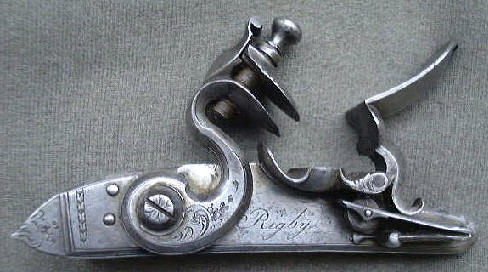
A flintlock marked "Rigby" with engraved cock, cock screw and lock plate
A close-up below of the frizzen and frizzen spring relationship illustrates the function of the roller. Notice that when a straight line is struck from the center of the frizzen screw thru the center of the frizzen foot and thru the center of the axle of the roller, the frizzen is at neutral. Just a few degrees of movement of the frizzen foot causes the spring over center and forces the frizzen in that direction. Notice the recesses to front and rear of pan.
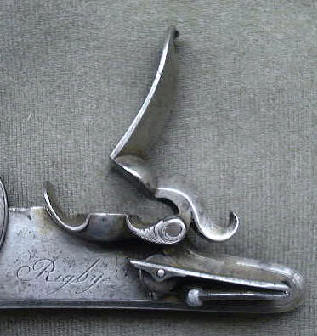
Below the inside of the lock is shown, notice that the lower limb of the mainspring when under maximum pressure at full cock is perfectly straight. The spring has been "balanced" by carefully filing a uniform taper both in height and thickness. The fancy pierced and filed bridal surface while aesthetically pleasing has no function. The internal parts are all casehardened and most are polished to the mirror finish, this finishing treatment is very resistant to corrosion. You can also see the inside view of the rainproof pan.
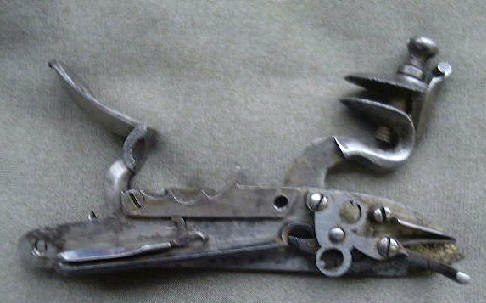
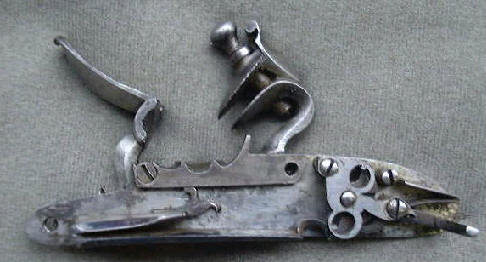
(with acknowledgement to an article "Overview of gunlocks" by Muzzleloaders Etcetera Inc.)
Nomenclature (names of the parts) of a flint lock
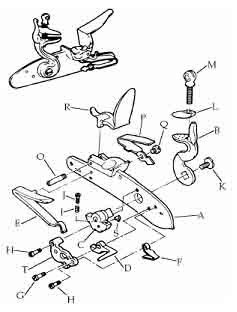
Parts list courtesy of Ardesa, SA Spain
|
A |
lock plate |
|
B |
hammer/cock |
|
C |
tumbler |
|
D |
sear |
|
E |
mainspring |
|
F |
sear spring |
|
G |
sear screw |
|
H |
sear spring screw |
|
I |
sear adjusting screw spring |
|
J |
sear adjusting screw |
|
K |
hammer screw |
|
L |
top jaw |
|
M |
top jaw screw |
|
O |
frizzen screw |
|
P |
frizzen spring |
|
Q |
frizzen spring screw |
|
R |
frizzen |
